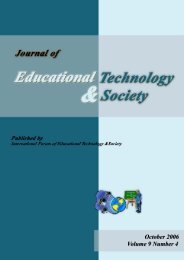Student Engagement: What do we know and what should we do?
Student Engagement: What do we know and what should we do?
Student Engagement: What do we know and what should we do?
You also want an ePaper? Increase the reach of your titles
YUMPU automatically turns print PDFs into web optimized ePapers that Google loves.
(p. 75). She adds that, until <strong>we</strong> clarify <strong>and</strong> communicate <strong>what</strong> student engagement means,<br />
<strong>we</strong> chance “it will fail to be taken seriously by many professional educators” (p. 75).<br />
Secondary to the difficulty in defining student engagement is difficulty measuring student<br />
engagement. Many questions remain about how to adequately <strong>and</strong> accurately measure<br />
student engagement. <strong>What</strong> <strong>do</strong>es real student engagement look like? For example, if<br />
student engagement is measured only by high school completion, <strong>what</strong> about student<br />
learning? If <strong>we</strong> detach engagement from achievement, <strong>what</strong> <strong>should</strong> <strong>we</strong> look for? If <strong>we</strong><br />
believe the goal of student achievement <strong>should</strong> not be a destination, but a journey, how<br />
shall <strong>we</strong> evaluate our success? <strong>What</strong> <strong>do</strong>es successful engagement look like? Perhaps this<br />
difficulty encourages our tendency to retreat to measures of achievement (Claxton, 2006),<br />
<strong>and</strong> not measures of learning. Obviously, more research is needed.<br />
Study the dynamic interplay bet<strong>we</strong>en various types of engagement<br />
<strong>Student</strong> engagement is complex <strong>and</strong> dynamic construct. As noted, educators note that <strong>we</strong><br />
have yet to underst<strong>and</strong> the term, never mind the interplay among different types of<br />
engagement – social, psychological, cognitive, academic, intellectual, behavioral, etc.<br />
The jury is out on whether all types of engagement are required for learning to be most<br />
effective. As Harris (2008) states,<br />
Future research <strong>should</strong> continue to investigate the relationship bet<strong>we</strong>en<br />
behavioural, psychological, <strong>and</strong> cognitive aspects of engagement <strong>and</strong> <strong>should</strong><br />
explore how teacher conceptions are translated into classroom practices. It would<br />
also be useful to investigate conceptions held by other educational stakeholders.<br />
This study suggests that future work on student engagement must aim to increase<br />
conceptual clarity instead of just adding new ideas to an already crowded<br />
construct (p. 75).<br />
Meyer <strong>and</strong> Turner (2006) suggest further studies on the integration <strong>and</strong> interrelation of<br />
cognition, motivation, <strong>and</strong> emotions (p. 384) <strong>and</strong> their impact on learning. They<br />
specifically note that the way “emotion, motivation, <strong>and</strong> learning evolve as coordinated<br />
processes as <strong>we</strong>ll as conflict with each other are not <strong>we</strong>ll explained in linear or<br />
hierarchical conceptualizations” <strong>and</strong> suggest creating new theories. Willms, Friesen, &<br />
Milton (2009) found that students <strong>we</strong>re “likely to experience social, academic <strong>and</strong><br />
intellectual engagement at different times <strong>and</strong> at varying degrees of intensity in their dayto-day<br />
lives at school” (p. 32), which creates challenges when it comes to implementing<br />
any particular strategy to increase student engagement for all students.<br />
While it is tempting to infer that if schools simply altered certain aspects of the<br />
learning climate (for example, by increasing effective learning time or raising<br />
expectations for success) students would increase their levels of engagement, one<br />
cannot make such strong causal inferences from cross-sectional data (p. 31).<br />
Along these same lines, more studies <strong>should</strong> work to correlate levels of challenge <strong>and</strong><br />
levels of engagement in learning. Dunleavy, et al. (2010, p. 3) refer to<br />
Csikszentmilhalyi’s initial research on “Flow”.<br />
<strong>Student</strong> <strong>Engagement</strong>: <strong>What</strong> <strong>do</strong> <strong>we</strong> <strong>know</strong> <strong>and</strong> <strong>what</strong> <strong>should</strong> <strong>we</strong> <strong>do</strong>? 49












